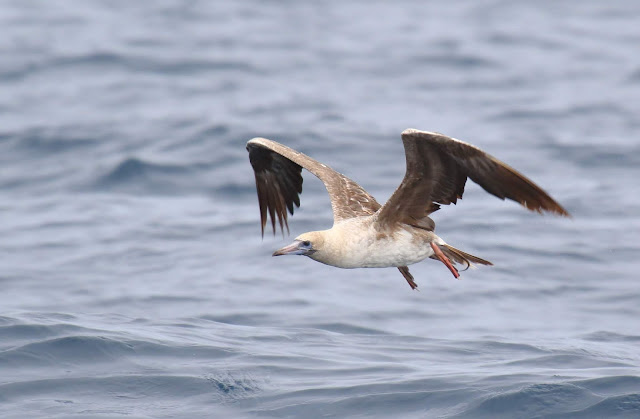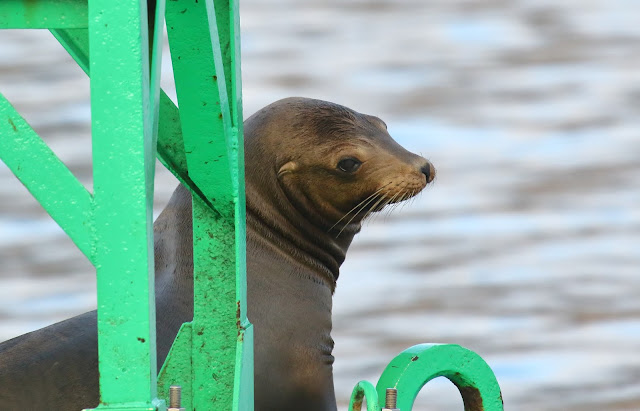What makes a good pelagic birding trip? It's a combination of seeing most of the expected avian species, often a good number of marine mammals and fishes, decent weather is nice but not required and, of course, rare birds. The best pelagic trips do not have just one very rare bird, but two or more.
I have attended over 200 West Coast pelagic trips. Eighty percent of those I set up and ran myself from Oregon. Over the years there have been many memorable pelagic trips--some amazingly so. First state records? Several. Second North American records? Two. Multiple rarities? Many times. All fantastic.
This past weekend I attended a
pelagic trip from San Diego that was another of those amazing trips. Was it the best ever? I don't know. That "best ever" target designation keeps moving.
 |
| Our trip begins at Point Loma marina, 7:06 am. |
 |
| Entering the ocean with Point Loma in the background, 7:40 am. |
It had wonderfully calm shirt-sleeve weather with light overcast to start. We had decent, if short, looks at a Blue Whale. We had the expected species, even if not everyone saw every species, or got the best looks, as expected from a boat at sea with 60 birders.
For instance, we had the expected southern California storm-petrels: Black, Ashy, Leach's, and a photo-confirmed Least. All three jaegers and a South Polar Skua were spotted (even if the Long-tailed Jaeger was impossibly distant and I saw the skua so poorly I didn't count it on my personal list). Brown Boobies (expected every trip now, the last 5 years). Craveri's Murrelets. Red Phalaropes. Sabine's Gulls. This was a very good pelagic trip even if these had been the only highlights.
And, in fact, we were more than half-way through our pelagic trip without any real rarities. We had traveled about 35 miles to where we were over an underwater seamount called Thirty Mile Bank. We had turned around and were heading back toward port, though making a large circle over the shallower edge of the bank that thrust above the often birdless valley known as the San Diego Trough.
And then the rarities! That's what puts this trip in the discussion with the very best. We had excellent close and prolonged views of excitingly rare (and large) birds.
Rare bird #1: Black-footed Albatross
 |
| Black-footed Albatross, 1:11 pm. |
At 1:00 pm the call went up of a Black-footed Albatross coming in. It soon flew us by, but then returned. It was with us for over 25 minutes.
Formerly rather common, this species has become quite rare the past 35 years in the warming offshore surface waters of southern California. In fact, waters off San Diego set several 100-plus-year records the previous week with temperatures of 80F. It was 74-77F on our trip. Single birds can be hoped for in May and June, so one in August isn't unheard of. But we were just getting started!
Rare bird #2: Red-footed Booby
 |
| Red-footed Booby, 1:28 pm. |
The albatross was still with us when the boat flushed a Red-footed Booby from the water at 1:23 pm. In fact, I switched back and forth between photographing the albatross and the booby!
A couple of Red-footed Boobies had been reported onshore during the week. So this species was on our radar. The first San Diego record was in 1996. There were only two accepted records by 2004. There were 3 records from 2010-2017. So they have been increasing, but are still very rare.
Rare bird #3: Masked Booby
 |
| Masked Booby, 2:29 pm. |
It was another hour later and we were still circling between two peaks about 4 miles apart above the Thirty Mile Bank. So we really weren't far from where we last saw the Black-footed Albatross and the Red-footed Booby. Then a large black-and-white booby flew up to us and inspected us. It didn't spend long with us, all my 60+ photos are from the same one minute period. But it was spotted enough in advance so that all got great looks as it flew along side and overtook us before peeling away.
The status of Masked/Nazca Boobies in southern California is not clear, as in immature plumages they are similar. Of course, immatures are more likely to wander north to California. San Diego has averaged about 2 Masked/Nazca boobies per year over the past decade. Most felt that California birds were primarily Masked Boobies. But then last fall and early winter up to 5 Nazca Boobies appeared inside San Diego Bay! And since then reports of both Nazca and Masked Boobies have been reported nearshore. My lifer Nazca Booby was January 1st this year in San Diego Bay and my first California Masked Booby was on a pelagic trip this past June when we had both Masked and Nazca!
Rare bird #4: Laysan Albatross
 |
| Laysan Albatross, 4:40 pm. |
About two more hours had passed and we had been running steadily eastward across the San Diego Trough. About 12 miles off San Diego we were crossing over the north end of the Nine Mile Bank, another underwater hill, which often brings nutrients and fish to the surface. We noticed far back of the boat an albatross. It was in our wake competing with the gulls for the popcorn we trailed continuously during the trip. It soon caught up to the boat. Due to time constraints we could only spend 10 minutes with this bird. But as you can see by the photo, we all got excellent looks as it flew and landed several times trying to get to the popcorn before the much smaller, but more aggressive gulls.
Laysan Albatross is a numerous species breeding on islands from Midway to Hawaii. Most of the population moves north to the Aleutians in the non-breeding season. So the species has been quite rare in southern California. In 1986 a population colonized islands in Mexico only 200 miles to the south of San Diego. Nevertheless, except for a couple of beach-cast dead birds, this species is rarely seen alive off San Diego. I was fortunate to see one in 2015 (
records here). This may be the 3rd or 4th accepted live record for the county, though there are a couple of additional reports of black-and-white albatrosses that are likely this species.
Rare bird #5: (Another) Red-footed Booby
 |
| Red-footed Booby, 6:40 pm. |
Guess what? As we were nearing port we got a report that a boat not far behind us had a Red-footed Booby on the bow. It had been riding with it all day (and would for another 3 days or so). It was not the same bird we saw! So we got prolonged looks as our boats paralleled each other for 20 minutes as we traveled back to the docks together. How many thousands of photos were taken of this bird? I took 135 shots and there were 35 or more people taking photos! Then more people came after dark to see the bird under the lights of the marina!
 |
| California Sea Lion |
 |
| Pink-footed Shearwater |
 |
| Black-vented Shearwater |
 |
| Leach's Storm-Petrel |
 |
| A raft of Black Storm-Petrels |
 |
| Can you spot the tiny Least Storm-Petrel among the Black Storm-Petrels? |
 |
| Juvenile Sabine's Gull |
 |
| Adult Sabine's Gull |
 |
| Craveri's Murrelets |
 |
| Juvenile Pomarine Jaeger |
 |
| Sooty Shearwater |
 |
| Juvenile California Gull |
 |
| Red-necked Phalarope (left front), Red Phalarope (right rear) |
 |
| Juvenile Brown Pelican |
 |
| Heermann's Gull |
 |
| Juvenile Brown Pelican |
























No comments:
Post a Comment
I really want to hear from you! I've changed settings (again) in order to try to make commenting easier without opening it up to spammers. Please note, however, that comments to posts older than 14 days will be moderated. Thank you.